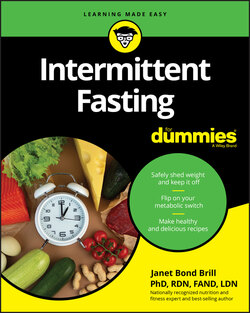Читать книгу Intermittent Fasting For Dummies - Janet Bond Brill - Страница 17
Examining the timeline of events
ОглавлениеWhat is the physiology of fasting? Although everybody responds to fasting a little differently (genetics, health, and age all play a role), there is a general timeline of events — a predictable set of metabolic responses as your fast stretches from hours into a day or longer. (For a much more detailed discussion of the different metabolic states your body goes through when practicing intermittent fasting, refer to Chapter 5.)
After fasting for a mere eight hours, here is the timeline of what happens in your body:
1 You have no food coming in, so you exhaust your supplies.Your body has tapped into your liver reserves of blood sugar to continue to keep your blood sugar level in the normal range. You’re now in what’s termed a catabolic or breakdown state.
2 You enter the fasted state; your liver has run out of its sugar reserves.This triggers the liver to manufacture new sugar from noncarbohydrate sources (scientifically termed gluconeogenesis) to continue to supply energy to the cells. With no carbohydrates consumed, the body creates its own sugar by using mainly fat. This marks the body’s transition into the fasting mode. Studies have shown that gluconeogenesis increases the number of calories the body burns, meaning when your metabolism starts to increase.
3 You flip your metabolic switch.One key mechanism responsible for many of the beneficial health effects of short-term, intermittent fasting is flipping of the metabolic switch. The metabolic switch is the body’s preferential shift from utilization of blood sugar to fat and fat-derived ketones for energy. In this step, your body breaks down fat, shuttling it to the liver, which creates ketones from fat to use for energy. The metabolic switch typically occurs between 12 to 36 hours after cessation of eating.
4 Extended fasts (longer than 36 hours) begin to slow metabolism down.That’s why you shouldn’t practice extended fasting with intermittent plans. After about 36 hours, the body stops using these energy sources (sugar and fat). The fasting mode then transitions to the more serious starvation mode.
5 You enter starvation mode.At this point, your metabolism has slowed dramatically, and your body begins to burn your own muscle protein for energy. The lack of essential nutrient intake plus using muscle for energy sets off an alarming cascade of dangerous complications.
During your recommended intermittent fasting periods, your fasting periods shouldn’t extend beyond 36 hours. Although some people choose to fast for up to 48 hours, I recommend your intermittent fasting periods don’t extend 36 hours because of the physiological reasons I mention here. Chapter 5 probes much deeper into the science of intermittent fasting.
